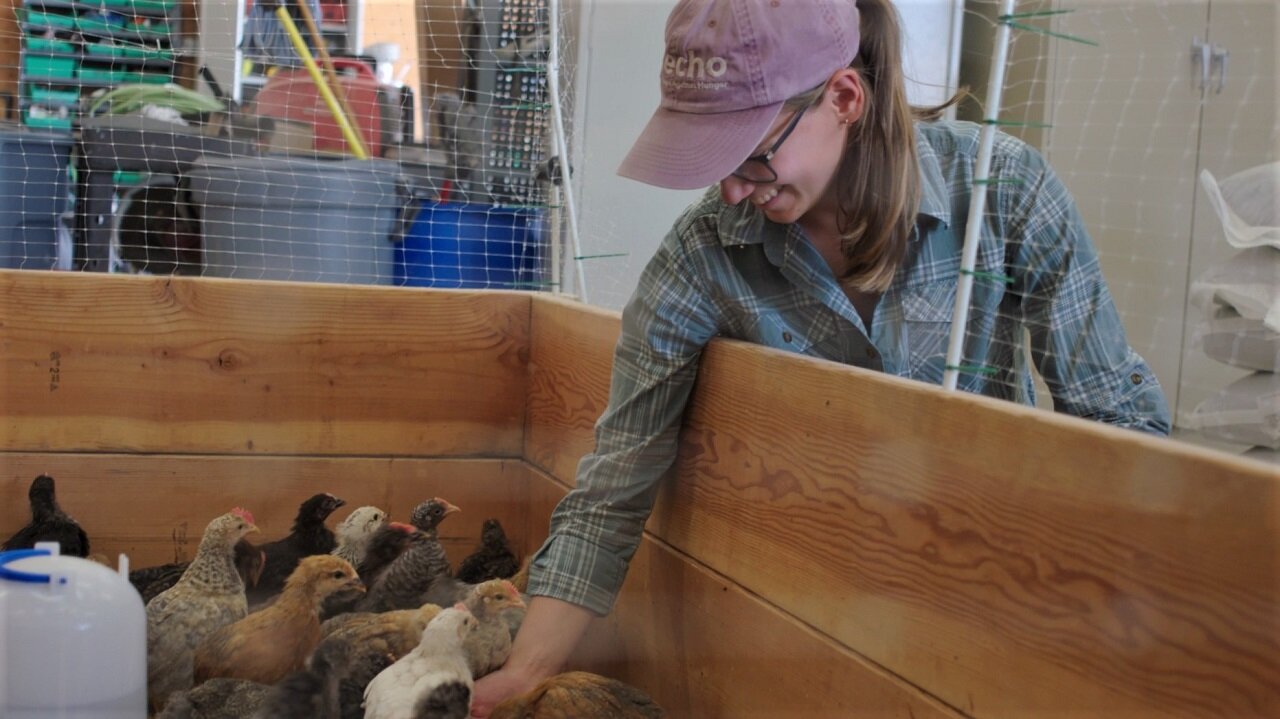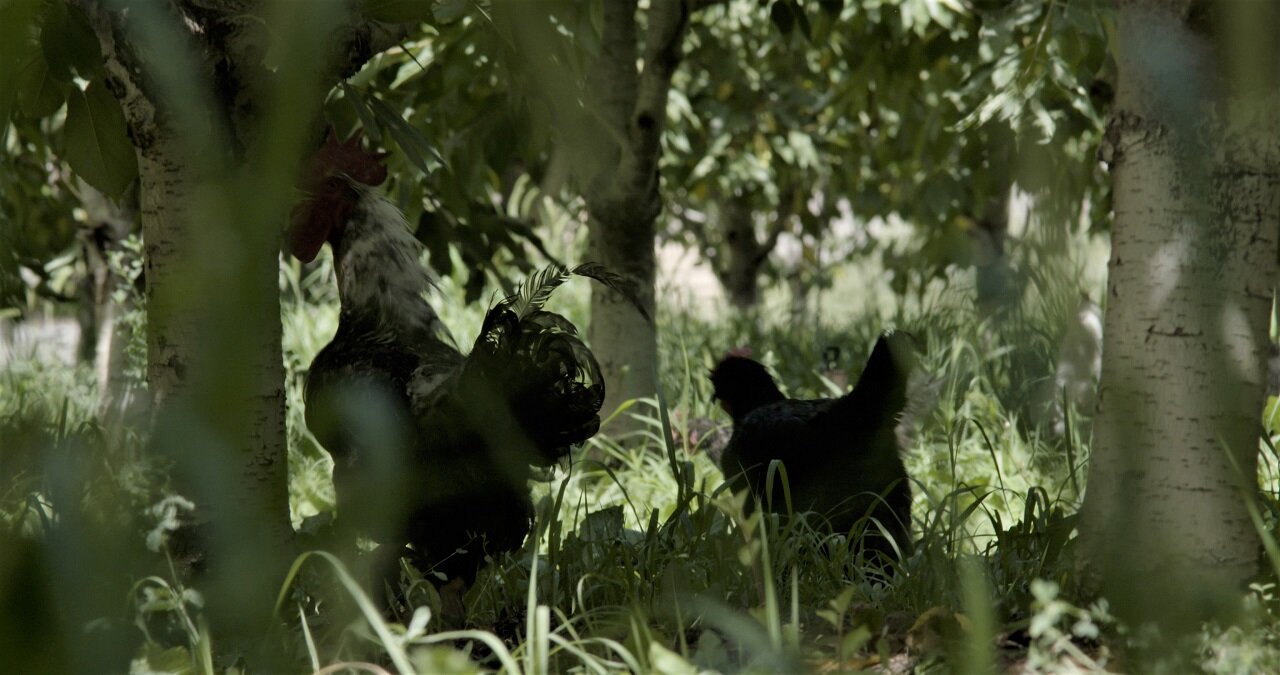Honey from the rock: A regenerative farm in Delta County lets Mother Nature do the work

DELTA COUNTY, Colo. — Every day, thousands of drivers on the highway from Grand Junction to Delta pass by an unimpressive dirt road, unaware of the orchard paradise at its end.
The fruity oasis is called Honey Rock Landing. The name landing is fitting, as it borders the Gunnison River, inviting rafters to park their rubber boats. Honey Rock is a reference to the Israelites wandering the desert after leaving Egypt. Fearful they would not find food or shelter, Moses sang to them, “God set them atop the highlands, to feast on the yield of the earth; nursing them with honey from a rock.”
The stretch of highway from Grand Junction to Delta is undoubtedly a barren landscape. For drivers, it is easy to go on autopilot and ignore the surroundings.
“It’s mostly what my dad would describe as ‘the stinking desert,’” said Colby Barrett, owner of Honey Rock Landing.
But those who take the road less traveled will descend into an amazing view of the Dominguez-Escalante National Conservation Area. Nestled in the river bed below is a vibrant oasis of peach, cherry, and pear trees.
There’s more to peaches than Palisade

“If you look at the micro-climates of western Colorado, they’re really characterized by a few things — especially for peaches — cold nights, hot days, fairly high elevation, a lot of sunlight,” Barrett explained. “This allows us to create a really good peach.”
These conditions are what make the Palisade Peach so famous, but Barrett likes to point out that there are a few more of these micro-climates in addition to Palisade, and the Gunnison River bottom between Grand Junction and Delta is one of them.
“So, whether it’s in the actual town limits of Palisade or another place that’s close with the same micro-climate, you’re still creating that optimal peach flavor,” Barrett said.
Barrett purchased the orchard about five years ago. “When we bought the orchard all the land on the east side was under-tree, kind of mismanaged and falling apart,” he said.
Barrett said the land has been farmed as far back as the 1890s. He feels like he is bringing an orchard back into production rather than starting a new one. He chose to resuscitate the whole operation using sustainable and regenerative methods.
A regenerative farm requires a big and diverse team. In addition to some scientists and experienced farmers, Barrett’s team includes bees, legumes, brassica and a herd of foraging orchard-roaming chickens.

Kelsey Sorensen (left), an agronomist and manager at Honey Rock, talks with Colby Barrett (right), the owner of Honey Rock.
Let Mother Earth do the work
“We’ve just found that if you can farm with nature versus against it, it’s just a lot easier,” Barrett said. “We always joke that we’re too lazy to fight nature.”
Previous orchardists used a lot of fertilizers and harsh sprays on the land. Barrett and his team had to wean the whole operation off of these methods.
When Barrett took over the orchard, aphids were a big problem. The conventional answer is to spray the aphids every spring when they show up. And they always do.
“What we’ve found is that kills all the predatory bugs as well,” he said.
Barrett decided to stop spraying chemical spray and let the aphids run their course.
“The first year we stopped spraying, the aphids were pretty bad,” he said.
Each year, Barrett introduced more beneficial predators like ladybugs. The team watched the ladybug population increase and the aphids decrease, finding a state of balance that enabled them to avoid chemical sprays.
Kelsey Sorensen is an agronomist and manager at Honey Rock. “To have a sustainable system, you need something that can run on its own,” she said.
In the desert, that means little to no water. It means planting low-water crops between the fruit trees that naturally produce nitrogen for the trees. It means “mow and blow:” mowing those crops and blowing them over onto the tree roots to provide mulch, nutrients and weed control. It means breeding chickens to be a pest-destroying army.
The Chicken army

Sorensen with pullets that will be egg-layers and orchard foragers.
Barrett is breeding chickens with two things in mind: to make chickens that lay a specific, colored egg that they can market as a Honey Rock egg and to have a team of foragers that limit the pest population in the orchards.
When asked about his chickens, Barrett smiled and said, “Our chickens are super amped because we just moved them from one of our older cherry blocks into our new one.”
A block refers to a section of trees in the orchard. The chickens know what to do. They scratch around the leaf litter at the base of the trees and are naturally attracted to eating the pests that would otherwise harm the trees.
“I don’t know how you tell the facial expressions of a chicken, but you can just tell they are happy,” Barrett said.

Chickens are thought to have originated in the jungles of Southeast Asia. These chickens appear to enjoy the safety of cover provided by the orchard trees.
A Thousand-Year Vision
Sorensen acknowledged this is a capitalistic venture, one where they are producing commodity crops. But commodity crops are usually associated with massive amounts of waste to produce.
“What we’re trying to do is to show that's not always the way it needs to be,” she said. “Agriculture can work with nature. It doesn’t need to be just taking.”
Both Barrett and Sorensen imagine a future with humans in it. They speak of a thousand-year vision for what they are doing at Honey Rock Landing. It may be a future with scarcer resources, and they are preparing a blueprint for how to thrive. Honey Rock is a business venture that must consider current economic systems. But, ultimately the operators are trying to create a proving ground to show what is possible in a climate that appears inhospitable, like honey from a rock.

The Gunnison River flows by the property.
Most of the fruit grown at Honey Rock Landing is sold through wholesale channels. But, anyone can get on their website and schedule an appointment to pick the fruit themselves while the fruit is ripe and on the trees.
Visitors can also schedule a tour. Sorensen loves to give tours and is especially excited when someone wants to know the science behind the methods.
“I have a thousand million things I could say … there’s so much science and nerdiness I could go into,” she said. “I mean we are doing every project you can imagine for farming down here.”
And they are. They are trying to develop a pepper that can grow with little-to-no water. They are trying to raise bees that thrive in the desert.
Barrett wants to show that it is possible to grow amazing produce in a barren landscape with minimal resources. “If we can get to a place where water from the Gunnison, and sun from the sky produces everything we need for the trees, that’s perfect,” he said.
Honey Rock Landing is a for-profit venture, to be sure, but everything they do is also in the name of educating the public about the possibility of better growing practices. Their website offers more information on the science of their orchard.
Cullen Purser is a multimedia journalist at Rocky Mountain PBS. You can reach him at cullenpurser@rmpbs.org.
